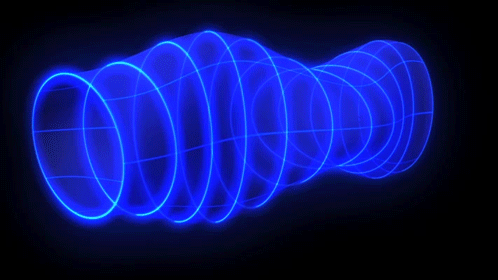Gravitational waves: ripples in spacetime
Almost everything we know about the cosmos is based on measurements of different types of light. This includes visible light, but also infrared and ultraviolet radiation, X-rays and radio waves. Recent advances in technology now allow for a completely novel way of studying our Universe, by measuring waves in the fabric of spacetime itself. These ‘gravitational waves’ are created by accelerating masses and travel towards us at the speed of light.
At the beginning of the 20th century, Albert Einstein released a very important theory on gravity. He proposed that gravity is not a force, but an effect created by heavy objects warping the fabric of spacetime. This works in a similar way to how a trampoline sags when you sit on it: any objects around you will start moving towards you. A spectacular consequence is that when heavy objects accelerate, they create ripples on the fabric.
A hundred years later the theory received one of the strongest evidences, when in 2015 the first direct discovery of gravitational waves was obtained by the advanced Laser Interferometer Gravitational-Wave Observatory (LIGO). These waves were created by a collision of two black holes. Since then, more detectors have become active on the ground on Earth and more gravitational waves have been observed.
Where do gravitational waves come from?

Gravitational waves are created when a mass is accelerated. For example, when you wave at your friend.
A source of gravitational waves is pairs of objects that revolve around each other, called binary systems. Depending on the detector, we can measure black holes or neutron stars as they spiral towards each other. During their orbits they get closer and closer, creating bigger and bigger waves, in a process called inspiral. The waves carry away rotational energy, allowing the two objects to get closer to one another and eventually collide. The clash sends out a final signal, called the ringdown – the aftereffects of the gravitational waves as they fade away.
Not only objects in binary systems are detectable. Single objects like spinning massive objects or dying stars can also send out gravitational waves. When neutron stars spin, any imperfection to their spherical form creates a gravitational signal. And when stars die and explode in supernovas, they spew out a lot of matter in an energetic outburst that generates gravitational waves.
LISA: the first gravitational space observatory

ESA’s future mission Laser Interferometer Space Antenna (LISA) is set to launch in the 2030s and will be the first space mission to observe gravitational waves. The mission consists of three spacecraft that fly in a triangular formation with arms of 2.5 million km. Using lasers, the distance between the spacecraft is monitored precisely. Gravitational waves passing through our Solar System will be detected by measuring the changes in distances between the three spacecraft.
LISA is complementary to gravitational observatories on Earth because it is sensitive to gravitational waves with different frequencies. Whereas ground-based observatories are great at detecting the collision of black holes and neutron stars, LISA will measure them in an earlier phase while they are still orbiting each other. For more massive systems, LISA will measure the inspiral, the merge and the ringdown. This will provide us with never-before-seen data on these processes which will allow us to better understand these extraordinary objects.
The observatory will be the first that can measure objects as light as white dwarf stars in binary systems. Impressively, LISA will also measure the waves coming from heavy compact objects like neutron stars falling into supermassive black holes at the centres of galaxies.















 Germany
Germany
 Austria
Austria
 Belgium
Belgium
 Denmark
Denmark
 Spain
Spain
 Estonia
Estonia
 Finland
Finland
 France
France
 Greece
Greece
 Hungary
Hungary
 Ireland
Ireland
 Italy
Italy
 Luxembourg
Luxembourg
 Norway
Norway
 The Netherlands
The Netherlands
 Poland
Poland
 Portugal
Portugal
 Czechia
Czechia
 Romania
Romania
 United Kingdom
United Kingdom
 Slovenia
Slovenia
 Sweden
Sweden
 Switzerland
Switzerland


























